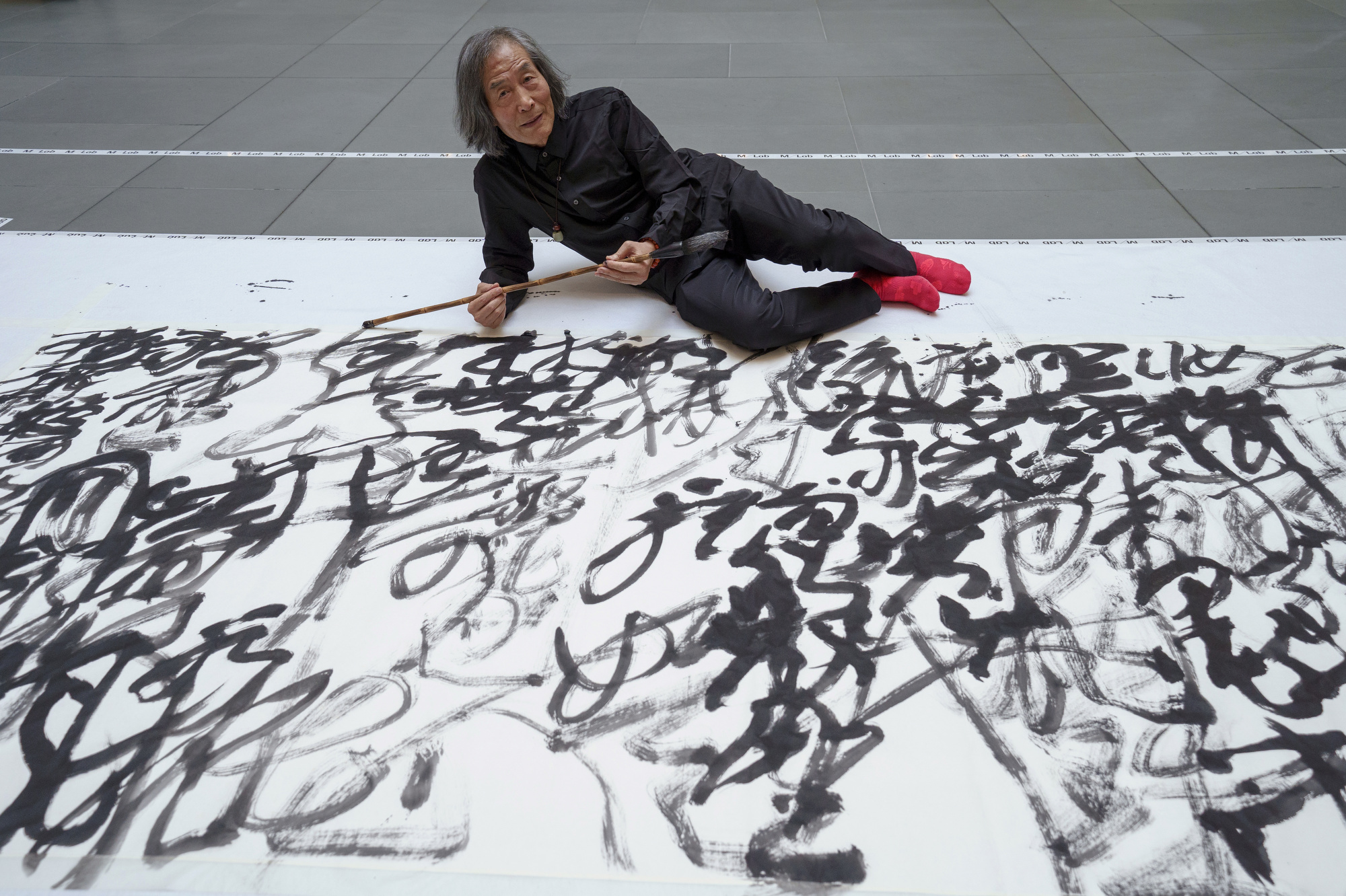At first it looked almost as if Wang Dongling was sweeping the floor with one hand, using a brush about a yard long. The graceful strokes trailed compacted, staccato black lines and sweeping curves on a rectangular white sheet the size of a living-room rug.
The artist, dressed in black, his dark hair collar-length with streaks of gray, has been creating large-scale calligraphic works for decades. On Friday, in front of an eager crowd gathered in the courtyard of the Harvard Art Museums, he did it again in “Flying Flowers and Scattered Snow: Wang Dongling’s Calligraphy of Su Dongpo’s West Lake Poems.”
Drawn with calligraphy ink on paper, Dongling uses his own brand of “chaotic script” (luan shu 亂書) to reproduce ancient texts of pictographic characters “that have been written down thousands of times before,” Sarah Laursen, the Alan J. Dworsky Curator of Chinese Art at the Harvard Art Museums said.
His style, she said, “could be seen as a descendant of the ‘wild cursive script’ of the Tang dynasty. However, he also draws inspiration from Abstract Expressionism, choosing to layer his characters on top of each other, and integrating physical performance into his practice — elements that have never been used in combination before.”
At Harvard, Dongling recreated the “West Lake” poems of Chinese poet, calligrapher, and essayist Su Dongpo. The poems depict the ornate scenery of the lake located in Hangzhou, China.
“He’s bringing that experience of his hometown, through these poems, all the way with him to Harvard.”
Shining (Christina) Sun
“It’s in the city where he has lived for decades,” said Shining (Christina) Sun, a doctoral student at Harvard’s Graduate School of Design. Sun is part of the team that helped organize Wang’s visit and served as his translator on campus.
“He’s bringing that experience of his hometown, through these poems, all the way with him to Harvard,” she said.
Onlookers gathered on both the ground and balcony levels to watch Dongling in action. Making swooping, inky strokes, the almost 80-year-old artist got lost in the work — placing characters in a way that looked almost predetermined, despite the improvisational nature of his process.
“He’s really focused when he does it,” Sun said. “He can either do it in isolated tranquility or among a huge crowd. But there’s an atmospheric interplay always going on.”
Dongling, through Sun, recounted a recent performance at the Belgian Royal Academy of Fine Arts. He said he totally blocked out the crowd and forgot anyone was watching until people started clapping.
That seemed to happen with the Harvard spectators as well, who watched intently through the nearly 30-minute performance. Polite applause broke out after the artist announced he was finished.
And despite his clear connection to the ancient, Dongling has begun exploring combining calligraphy with modern technology.
“He actually has works where he uses Virtual Reality to create a 3D installation,” Sun said. “He has done not only VR but also projective technologies, where he projected art on top of another piece of words, like Matisse. So he creates that palimpsest between the ancient and current.”
Hosted in conjunction with the Harvard Art Museums Materials Lab, or M/Lab, the demonstration was part of an effort to facilitate interactions between the public and experts in the art world.
“My co-organizer at the M/Lab, Francesca Bewer, and I were also very excited that the performance could take place in the Calderwood Courtyard, with its vantage points on every floor. This took many hands behind the scenes, from facilities and collections management to the director’s office,” Laursen said.
The Art Museums are in the process of formally acquiring the artwork created last week, as well as the brush used to create it. Once they have entered the collection, they will be available for students and other researchers to view in the Art Study Center by appointment and may be used in future exhibitions.
Laursen added that for those interested in seeing some of Dongling’s inspirations, works by Pablo Picasso, Henri Matisse, and Joan Miró are currently on view on the first floor of the museums.
“In particular, I would encourage readers to visit Jackson Pollock’s “No. 2” (1965.554) in Gallery 1200 and think about the energetic but controlled physical movement of the artist as he created the work and the rhythmic balance of light and dark,” she said.
The museums are open and free to the public Tuesday through Sunday, from 10 a.m. to 5 p.m.
Source link

